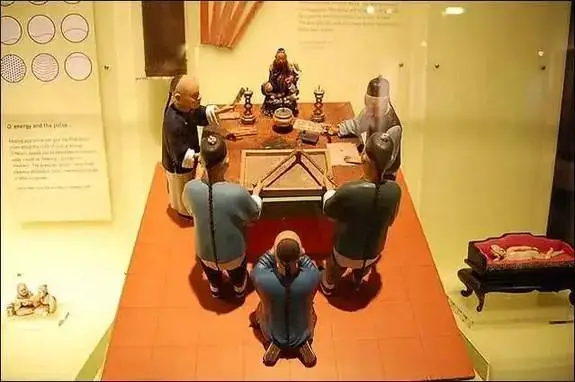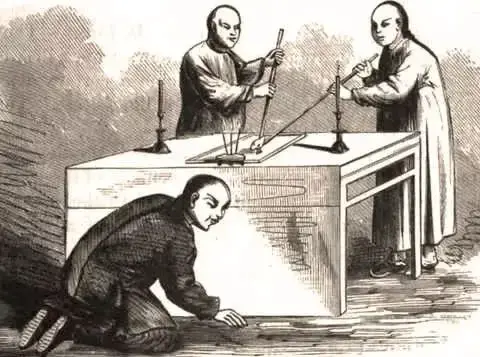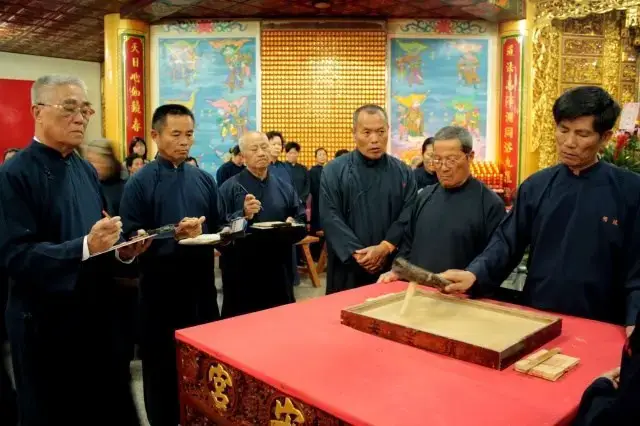When it comes to spirit writing, the Fuji planchette is one of the most renowned tools. Examples of similar implements are the dragon’s bones and the ki. Spirit writing is supposed to be a means to get comprehensible messages from the spirit world in the form of written text. Its use to summon different kinds of spirits is very controversial, praised for its powers to help those who use it get or know whatever they wish, but vilified by most for its potential to summon evil.
Planchette Writing Meaning

A planchette is French for “little plank”, and refers to a small, normally heart-shaped flat piece of wooden apparatus that has two wheeled casters under it and a pencil-holding gap pointing downwards that acts as the third support. Planchette writing is achieved when a person places their fingers using one hand on the wood and the pencil scribbles automatically, or seemingly by spirit control through psychic force from the medium.
Planchette’s writing was originally espoused to solve human challenges and promote artistic abilities. As such, it was used to ask for cures, to help resolve doubts, to write poems, reply to poems, and for teaching.
Planchette Writing History

The name Planchette comes from a French spiritualist who invented and popularized the little plank in France for use by French spiritualists in 1853 CE. In 1868, an American toy maker took the idea and placed thousands of planchettes in booksellers, making it a popular plaything in both the United Kingdom and the United States.
However, the idea of such a device had long existed in China and was nobody’s toy. Spirit writing can be traced back to 420–479 CE, during the Liu Song Dynasty. There is evidence that Fuji planchette-writing was popular from 960–1279 CE during the Song Dynasty and that it was even banned from 1644–1912 CE during the Qing Dynasty. During the Ming dynasty, from 1368–1644 CE, the Fuji method changed from using a suspended sieve to directing a stick, more like the French planchette. Even after the Qing dynasty period suspension of the practice, it continued. Today, you can find it in folk shrines in China and in Daoist temples in Hong Kong, Taiwan, and Malaysia.
Planchette Symbolism

The planchette is symbolized by a small triangular shape or a heart-shaped board on two casters at the two bottom points, the third support being a vertical pencil. The pencil is believed to move automatically and write as directed by spirits when the board is lightly touched with the fingers. A similar board, with a gap to hold the pencil but without it, can also be used to symbolize the planchette.
What Is A Planchette Used For
The planchette is meant to be a means of divination. It is used to contact the dead and other entities in the spirit world to help with human challenges. It works by writing out responses to questions asked aloud.
Pen Fairy Game
The pen fairy game invites a spirit to answer questions with a yes or a no that one would be curious about. The one rule is that you cannot ask the spirit about their own personal things. The other is to ask questions that have simple yes or no answers. To play, two people sit in the dark with only candlelight, face-to-face with a table between them. A piece of white paper is placed on the table. The two people hold a pen loosely between them. They invite the pen fairy by chanting, “Pen fairy, please come.” The pen fairy will make their presence known by shaking the pen. You can ask the pen fairy any question. The pen will write an “X” or a “check” depending on whether the answer is a yes or a no.
Conclusion
Whether you believe in the ability to communicate with the dead or not, it is hard to dismiss the interest that planchettes and Ouija boards have continued to generate over hundreds of years. There seems to be an out-of-the-ordinary phenomenon that goes on around their use. A plausible “scientific” explanation is that the movements are a result of the ideomotor response—unconscious muscular actions that are transmitted onto the board. Whether this is the case or not, planchettes should be used with caution.
Hello, in the picture under the title “Planchette Writing History’ what is the man who is kneeling in front of the table doing? Is he shaking the table maybe?
pray